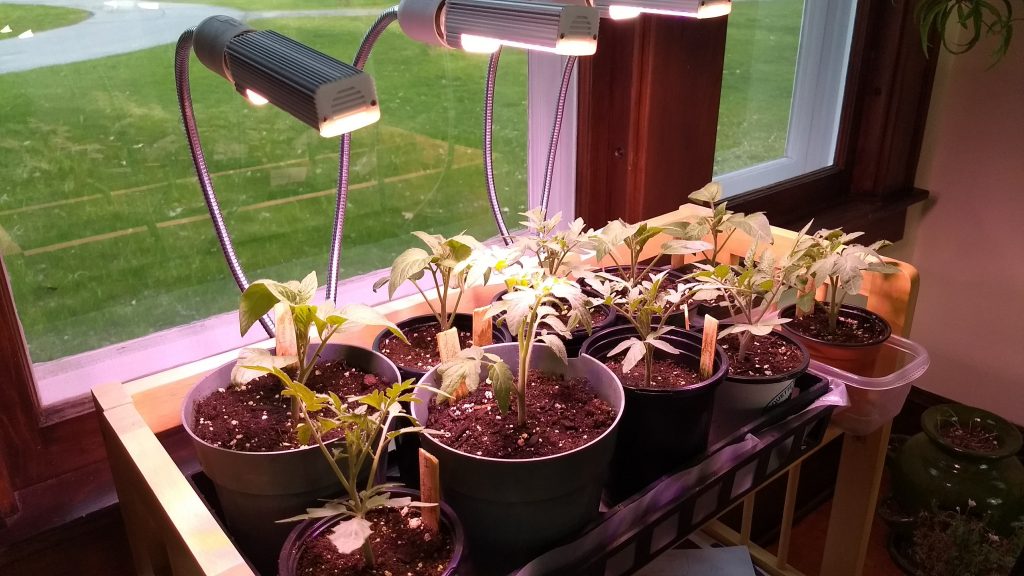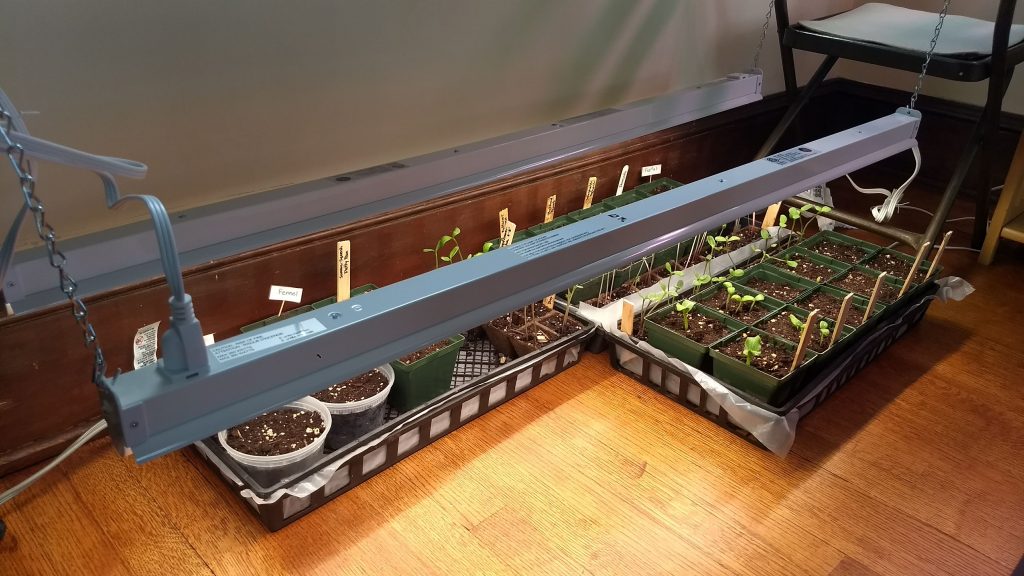With the pandemic upon us and a bit of extra time at home, Alison and I have been diving into preparations for vegetable gardening. One of those preparations was getting some grow-lights so that all of the tomatoes, squash, peppers, and other veggies Alison is starting from seeds can get a sufficient jump start before they get placed in the ground for our short growing season.
As we researched grow-lights we found a wide variety of options and tons of advertising copy that touted the benefits each model, but it seemed like most of the consumer-grade options we found either didn’t provide accurate analysis of the lights’ output or used differing testing methodologies that couldn’t be directly compared. Add to that the vast range of form-factors the lights come in and we found our heads spinning trying to decide which ones to buy.
As a reference, here are a few of the terms you might encounter when shopping for lights:
- Photosynthetically Active Radiation (PAR)
Because plants absorb some colors for photosynthesis (mostly longer red wavelengths and shorter blue/violet wavelengths) and reflect others (medium yellow/green wavelengths), lamps that output a higher proportion of their light in colors plants can use will be more efficient at delivering useful light to the plants than lamps that put most of their power into the yellow part of the spectrum that we find pleasing for household illumination. - Photosynthetic Photon Flux (PPF)
The number of photons in the PAR range that are emitted from the lamp during a given time. Units are micromoles (µmol) per second (s). - Photosynthetic Photon Flux Density (PPFD)
The number of photons in the PAR range that are emitted from the lamp and impact a given area below the lamp during a given. Units are micromoles (µmol) per second (s) per square meter (m^2).
While PPFD seems like it would be the best common descriptor of a lamp’s performance (how much useful light is it able to get to a certain area of plant leaves), different manufacturers may make different assumptions on distance to plants and configuration of lamps which make these values (when even reported) hard to directly compare.
In addition to the incomparable measurement techniques and different units reported manufacturers, we are also faced with a knowledge gap about what light our variety of vegetable seedlings might even need. For large commercial growers or those doing year-round indoor growing, it’s probably worth it to dive more into the science of the light needs of the plant species being grown and the capabilities of the lamps available. For us however, our initial research suggests that a big boost of light will work well enough to get the seedlings going. We will only operate a few lights for about a month and a half at most, so absolute efficiency of power utilization isn’t such a huge factor. The commercial-grower-focused arrays are too expensive to be worth the investment for our limited use and many put out so much power that they need loud cooling fans to keep them at operational temperature — not something we want to listen to while writing an email in the same room.
Based on a recommendation from an acquaintance, we somewhat blindly started out with two “Relassy” clip on goose-neck lamps (each unit has two bulbs for 4 total bulbs). Given that these were $23/unit, it seemed worth the small cost to get the tomatoes going ASAP.
After successfully starting way too many tomatoes (24 starts were given away to neighbors), it was time to begin sprouting squash, cucumbers, sunflowers, peppers, and other veggies. The clip-on lamps we already had seemed to be effective, but were awkward to position over many trays of seedlings sitting on the floor. Looking into additional lights threw us back into the confusion of many options with differing reported abilities that were impossible to compare. Additionally, we noticed that some lamps claimed to output more Watts of light than they drew in electricity — an impossible violation of the first two laws of thermodynamics. This claimed “Watts of light” in the product descriptions turned out to really mean “light output equivalent to that produced by a High Pressure Sodium (HPS) or Metal Halide (MH) florescent grow lights that would draw X Watts of electricity” — talk about a roundabout unit!
A way forward
Stepping back from the confusing product descriptions we realized that with two assumptions, we could relatively easily compare grow-lights for our needs and find decent options we could be happy with.
Assumption 1: LED efficiency is about the same
While LED efficiency may vary considerably, most reports I’ve been able to find indicate that most LEDs convert about 40-50% of the electric energy they draw to usable light, with the rest of the energy wasted as heat. Taking this range as a given yields a 20% performance difference between the high and low ends, a difference that I think won’t matter for my decision making.
Assumption 2: Maybe PAR doesn’t really matter…
Our next simplifying assumption is that as long as the lamps that we are looking at are purpose-built grow-lights that give more blue & red light than yellow, that they will be good-enough for our purposes. Some might be a bit better than others, but the big thing our vegetable starts apparently need is more light in bulk rather than precisely focused wavelengths. Soon enough they will be in full sun for the rest of the growing season, so our hunch is that particular tuning of wavelengths is an unnecessary optimization that dramatically adds to the comparison confusion.
Corollary:
Given these two assumptions: (1) that grow-specific LEDs are roughly equal in their efficiency at converting electricity to light and (2) they output light that is mostly useful to plants, I believe that I can assume that electricity draw is a reasonable proxy by which to compare the light output of consumer-grade LED grow-lamps.
While electricity draw certainly isn’t perfect as a measure of light output, it has a huge advantage: it is trivial to measure/validate and it seems to be accurately reported by most manufacturers and sellers. Product descriptions may report whatever light measurements make their product sound good, but it is really hard to fool a basic power meter — switch on the lamp and the bulb is going to draw what it will draw.
Comparing lights
Decision factor 1: cost of light output
With “Watts of electricity draw” as my proxy for light output, I can then take the next step and find good deals by looking at lamps by their dollars per Watt (of electricity draw). As an example, the “Relassy” clip on goose-neck lamps are $22.59 per unit and each unit draws 15 W of electricity, giving a ratio of $1.51/W. In contrast the $74.98 “toggled” 32 W, 4-foot lamp from Home Depot has a cost of $2.34/W, quite a bit worse.
Decision factor 2: coverage
What we really want to do is get usable light shining on vegetable seedlings. While a single super-bright point source might output the same amount of light as a long bar, the point source will have a lot more intensity in the center of its lit area than the edges while the long bar will have more even light along its length, though tapering to the sides. Depending on how many trays of seedlings one might need to grow and how you want to arrange them (floor, shelving, tables, etc), different configurations of the same total output might be preferable to you. Some designs will be small enough that you can place several side-by side to increase the light intensity, while others will totally cover the area and preclude combining.
However you slice it, I found it was useful to look at how many Watts (of electricity) a lamp could use to shine light on each square foot of seedling-trays. For a given configuration of lamps this would give you a certain number of Watts per square-foot.
Decision factor 3: form factor
Some lights are just bulbs that screw into standard medium-base sockets, others are clip-on goose-necks, 2-foot-long tubes, 4-foot-long tubes, flat-panel arrays, and many more. Depending on how how you want to suspend them over your seedlings, one form factor might be preferable to another. Potentially loud cooling fans are element of form factor that might be an issue for some designs.
The clip-on goose-necks we started with worked well for delivering 15 W per square foot on top of a 2-foot wide book-shelf, but the thought of adding an additional 8 units (16 goose-necks) to cover another 4 trays (~8 square feet) at the same light level is daunting.

Instead, we ended up buying two 4-foot long GE 30-Watt lamps ($50 each, $1.67/W) as our additional lighting. This pair draws a total of 60 W and we have it currently configured to illuminate about 8 square feet of trays at an intensity of 7.5 Watts (electricity) per square-foot illuminated. We can move them closer together and/or hang several more lamps side-by-side to increase the intensity of light on each square foot without too much hassle other than the additional cost of fixtures. These are a little more expensive per Watt than the “Relassy” lights, but GE is a comparably reputable manufacturer, claims that their spectrum is tuned toward seedlings and greens, and the form-factor isn’t quite as fussy.

Conclusions
The big caveat is that I’m a totally novice gardener and don’t know how much light seedlings actually need. I assume that more is better, but there is probably a minimum level of light to keep them from withering and getting leggy. Maybe that is 7 Watts (electricity) / square foot, maybe 3, maybe 10, or more. 15 W / square foot seemed to make our first round of tomatoes pretty happy in a sunny room, noticeably more than the seedlings that were just getting sun. We’ll have to try again with half the light intensity and see if they still do as well.
While I can’t tell you how much light your plants actually need, hopefully this post can at least help cut through the confusing product descriptions and allow you to compare apples to apples without getting stuck in the rabbit hole of incomplete data and differing ways of measuring and reporting light output.
I’m open to the fact that I also might be wrong on some of my assumptions. Or if not wrong, maybe there is important nuance I’m missing that has a bigger effect than I’m giving it credit for. Feel free to correct me in the comments. 🙂





